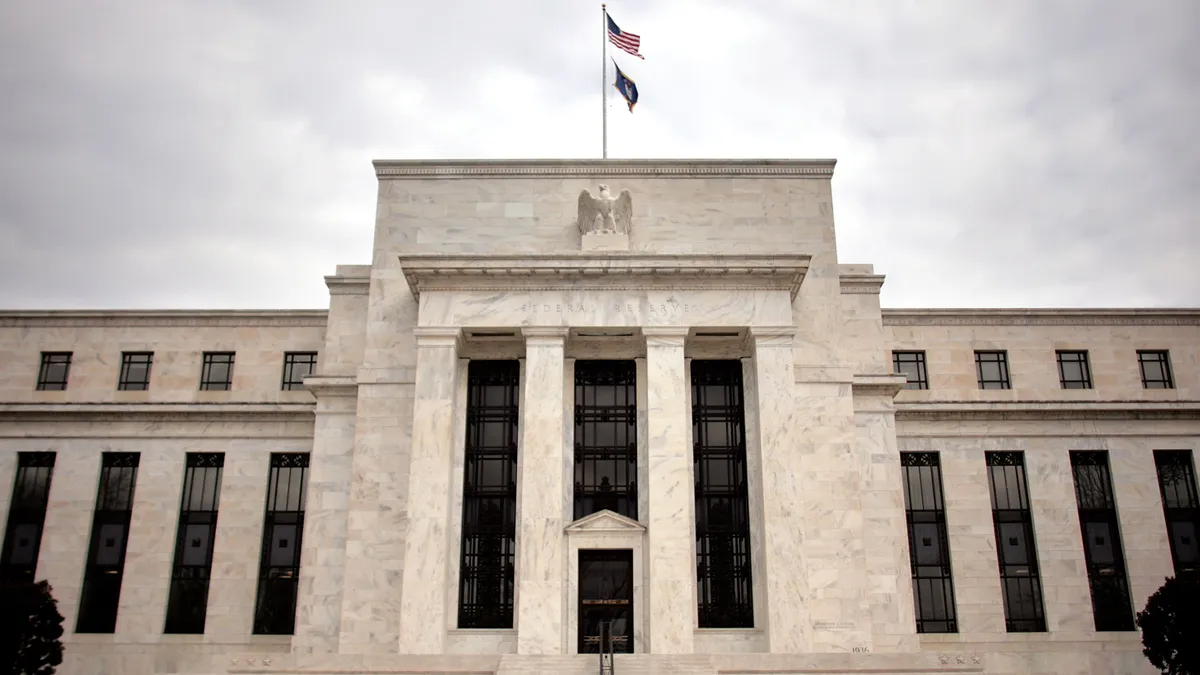Dive Brief:
- The Federal Reserve raised the main interest rate 0.75 percentage point Wednesday, intensifying its fight against the highest inflation in nearly four decades while signaling that in coming months it may slow the fastest pace of policy tightening since the 1980s.
- Fed Chair Jerome Powell said policymakers may consider raising borrowing costs less at meetings in December and February but stressed that they may ultimately increase interest rates higher than they forecast in September. A pause to the pullback in stimulus is not on the table, he said.
- “We still think there’s a need for ongoing rate increases,” Powell said during a press conference after a two-day meeting by the Federal Open Market Committee. “We have some ground left to cover here and we will cover it.”
Dive Insight:
The Fed has raised the federal funds rate this year from near zero to a range between 3.75% and 4% but achieved mixed success at cooling demand and reducing inflation.
The economy slowed from January through September, manufacturing is close to contraction and the housing market is in a slump. At the same time, the job market has remained overheated and consumer demand, while easing, is still strong.
Inflation gauges also show that the Fed’s most aggressive fight against inflation since the 1980s has yielded mixed results at best.
The withdrawal of stimulus slowed the 12-month gain in the Consumer Price Index to 8.2% in September from 9.1% in June, the highest inflation in 40 years.
At the same time the Fed’s preferred measure of inflation – the core personal consumption expenditures price index excluding volatile food and energy prices – increased 5.1% on an annual basis in September compared with 4.9% in August, the Labor Department said Friday. Policymakers aim to limit inflation to 2%.
Inflation “has come down, but not to the extent we had hoped,” Powell said, adding later in the press conference that “there’s no sense that inflation is coming down.”
“The inflation picture has become more and more challenging over the course of this year, without question,” he said. “That means that we have to be more restrictive, and that narrows the path of a soft landing,” or the prospect that the Fed will reduce price pressures without causing a recession.
When combating inflation, policymakers try to find a sweet spot between tightening too little and too much. An excessive pullback in stimulus may cause a downturn, hurting business and increasing unemployment. Insufficient tightening may allow inflation to persist and root deeper in the economy.
The Fed's effort to find a sweet spot is especially challenging because it may take 12 months or longer for the impact from an increase in the benchmark interest rate to fully surface in the economy.
Fed officials have expressed particular concern that, even with higher borrowing costs, the labor market remains red hot and threatens to spark an increase in wages.
“The broader picture is an overheated labor market where demand exceeds supply,” Powell said.
Private payrolls increased 239,000 in October after gaining 192,000 in September, ADP Research Institute and the Stanford Digital Economy Lab said Wednesday.
Layoffs in September declined and job openings increased 437,000 to 10.7 million, far exceeding the 5.8 million people seeking employment, the Labor Department said Tuesday.
Roughly 4.1 million workers quit their jobs in September, the Labor Department said. The quits rate, or the number of workers who left their jobs as a percent of total employment, held at 2.7, well above the pre-pandemic level and an indication that workers are confident of getting higher-paying jobs elsewhere.
“We would love to see vacancies coming down, quits coming down,” Powell said. While indicating that the central bank needs to tighten further, he suggested that it may consider increases less than 0.75 percentage point at its next two meetings on Dec. 13-14 and Feb. 26-27.
Fed officials have pledged to withdraw stimulus and hit their inflation target even at the risk of a setback for businesses and a slump in employment.
Powell reiterated on Wednesday that the Fed would err on the side of being too restrictive.
“From a risk management standpoint, we want to make sure that we don’t make the mistake of either failing to tighten enough or loosening policy too soon,” he said.
“If we were to over-tighten, we could then use our tools strongly to support the economy,” he said. “Whereas if we don’t get inflation under control because we don’t tighten enough, now we’re in a situation where inflation is now entrenched and the employment costs, in particular, will be much higher potentially.”
By one measure, monetary policy is still accommodative: The federal funds rate still lags inflation even after four consecutive rate hikes totaling 3 percentage points.
Defending Fed policy, Powell noted that inflation exceeds borrowing costs. “It’s very difficult to make a case that our current level is too tight given that inflation still runs well above the federal funds rate.”















